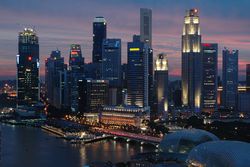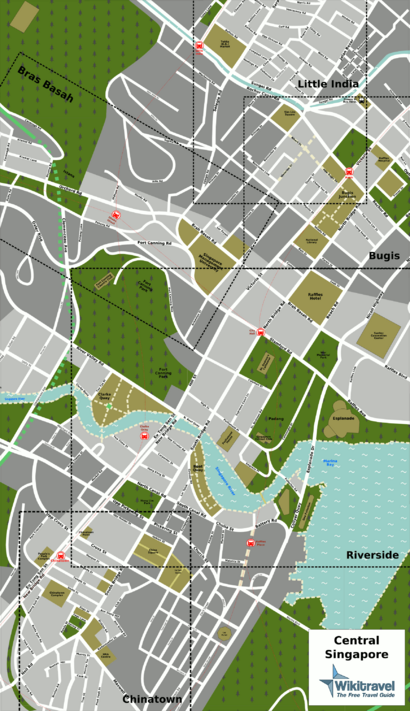Singaporeis an island-state in Southeast Asia, connected by bridges to Malaysia. Founded as a British trading colony in 1819, since independence it has become one of the world’s most prosperous countries and sports the world’s busiest port. Combining the skyscrapers and subways of a modern, affluent city with a medley of Chinese, Indian and Malay influences and a tropical climate, with tasty food, good shopping and a vibrant nightlife scene, this Garden City makes a great stopover or springboard into the region.

Location
History
The first records of Singapore date back to the 2nd-3rd centuries where a vague reference to its location was found in Greek and Chinese texts, under the names of Sabana and Pu Luo Chung respectively.
According to legend, Srivijayan prince Sang Nila Utama landed on the island in the 13th century and, catching sight of a strange creature that he thought was a lion, decided to found a new city he called Singapura, Sanskrit for Lion City. (There have never been any lions on Singapore, so the mysterious beast was more probably a tiger.) More historical records indicate that the island was settled at least two centuries earlier and was known as Temasek, Javanese for "Sea Town". However, Sumatran Srivijaya fell around 1400 and Temasek, battered by the feuding kingdoms of Siam and the Javanese Majapahit, fell into obscurity, eventually being absorbed into the Melaka Sultanate and later the Johor Sultanate.
The story of Singapore as we know it today thus began in 1819, when Sir Thomas Stamford Raffles made a deal with a claimant to the throne of the sultan of Johor: the British would support his claim in exchange for the right to set up a trading post on the island. Well-placed at the entrance to the Straits of Malacca, straddling the trade routes between China, India, Europe, and Australia, Raffles’ masterstroke was to declare Singapore a free port, with no duties charged on trade. As traders flocked to escape onerous Dutch taxes, the trading post soon grew into one of Asia’s busiest, drawing people from far and wide. Along with Penang and Malacca, Singapore became one of the Straits Settlements and a jewel in the British colonial crown, and its economic fortunes received a further boost when palm oil and rubber from neighbouring Malaya were processed and shipped out via Singapore. In 1867, Singapore was formally split off from British India and made into a directly ruled Crown Colony.
When World War II broke out, Fortress Singapore was seen as a formidable British base, with massive naval fortifications guarding against assault by sea. However, not only did the fortress lack a fleet as all ships were tied up defending Britain from the Germans, but the Japanese wisely chose to cross Malaya by bicycle instead. Despite hastily turning the guns around, this was something the British had not prepared for at all, and on February 15, 1942, with supplies critically low after less than a week of fighting, Singapore ignominiously surrendered and the colony’s erstwhile rulers were packed off to Changi Prison. Tens of thousands perished in the subsequent brutal occupation, and the return of the British in 1945 was less than triumphal — it was clear that their time was up.
Granted self-rule in 1955, Singapore briefly joined Malaysia in 1963 when the British left, but was expelled because the Chinese-majority city was seen as a threat to Malay dominance, and the island became independent on 9 August 1965. The subsequent forty years of iron-fisted rule by Prime Minister Lee Kuan Yew saw Singapore’s economy boom, with the country rapidly becoming one of the wealthiest and most developed in Asia. Now led by Lee’s son Lee Hsien Loong, the ruling People’s Action Party (PAP) continues to dominate the political scene, with 82 out of 84 seats in Parliament (over half won unopposed) and opposition politicians regularly bankrupted by defamation suits. Societal restrictions have been loosened up in recent years though, with the government trying to shake off its staid image, and it remains to be seen how the delicate balancing act between political control and social freedom will play out.
See

Map of central Singapore, with outlines of detailed region maps
Sights in Singapore are covered in more detail under the various districts. Broadly speaking:
Eat
Singaporeis a melting pot of cuisines from around the world, and many Singaporeans are obsessive gourmands who love to makan ("eat" in Malay). You will find quality Chinese, Malay, Indian, Japanese, Thai, Italian, French, American and other food in this city-state.
Eating habits run the gamut, but most foods are eaten by fork and spoon: push and cut with the fork in the left hand, and eat with the spoon in the right. Noodles and Chinese dishes typically come with chopsticks, while Malay and Indian food can be eaten by hand, but nobody will blink an eye if you ask for a fork and spoon instead. If eating by hand, always use your right hand to pick your food as Malays and Indians traditionally use their left hand for dirty things like washing up after using the restroom. If eating in a group, serving dishes are always shared, but you’ll get your own bowl of rice and soup.
Keep an eye out for the Singapore Food Festival, held every year in July. During the last three festivals, all visitors to Singapore smart enough to ask for them at any tourist information desk received coupons for free chilli crab, no strings attached!
Drink
Coffee shops
Despite the name, coffee shops or kopitiam sell much more than coffee — they are effectively mini-hawker centres with perhaps only half a dozen stalls (one of which will, however, sell coffee and other drinks). The Singaporean equivalent of pubs, this is where folks come for the canonical Singaporean breakfast of kopi (strong, sugary coffee), some kaya (egg-coconut jam) toast and runny eggs, and this is also where they come to down a beer or two and chat away in the evenings.
For those who wish to have restaurant style service with a distinctly Singaporean atmosphere, many coffee shops sell tsu cha (煮炒) for dinner, which is essentially various dishes being served to your table like they do at Chinese restaurants, though the food is usually cheaper and much more localised than restaurant food. Popular dishes include sam lo hor fun (三捞河粉), prawn paste chicken (蝦醬鷄) and many others.
The usual Starbucks and other local cafe chains such as Coffee Bean & Tea Leaf can be found in any shopping mall but an iced coffee or tea can put you back $5 and up, whereas a teh tarik ("pulled" milky tea) or kopi coffee runs closer to $1 at any hawker centre.
Alcohol
Alcohol is widely available, but is very expensive due to Singapore’s heavy sin taxes. Tax-free at Changi Airport, on the other hand, has some of the best prices in the world; you can bring in up to one liter each of liquor, wine and beer. Careful shopping at major supermarkets will also throw up common basic New World (read: Oz) wine labels on special prices in the mid to late teens.
Prices when eating out vary. You can enjoy a large bottle of beer of your choice at a coffee shop or hawker center for less than $6 (and the local colour comes thrown in for free). On the other hand, drinks in any bar, club or fancy restaurant remain extortionate, with a basic drink clocking in at $10-15 while fancy cocktails would usually be in the $15-25 range. On the upside, happy hours and two-for-one promotions are common, and the entry price for clubs usually includes several drink tickets. Almost all restaurants in Singapore allow bringing your own (BYO) wine and cheaper restaurants without a wine menu usually don’t even charge corkage, although in these places you’ll need to bring your own bottle opener and glasses. Fancier places charge $20-50, although many offer free corkage days on Monday or Tuesday.
Tourists flock to the Long Bar in the Raffles Hotel to sample the original Singapore Sling, a sickly sweet pink mix of pineapple juice, gin and more, but locals (almost) never touch the stuff. The tipple of choice in Singapore is the local beer, Tiger, a rather ordinary lager, but there’s been a recent microbrewery boom with Archipelago (Boat Quay), Brewerkz (Riverside Point), Paulaner Brauhaus (Millenia Walk) and Pump Room (Clarke Quay) all offering interesting alternatives.
Tobacco
Tobacco is heavily taxed, and you are not allowed to bring more than one opened pack (not carton, but single pack!) of cigarettes into the country. This is particularly strictly enforced on the land borders with Malaysia. Many public places including hawker centres have restrictions on smoking, and it is prohibited in public transport as well. There is a total ban on smoking in all air-conditioned places, and strict limitations on where you can smoke outside as well (eg. bus stops and all except the designated sections of hawker centres are off limits). The designated zone should be marked with a yellow outline, and may have a sign reading "smoking zone".
Prostitution
Prostitution is tolerated in six designated districts, most notably Geylang, which — not coincidentally — also offers some of the cheapest lodging and best food in the city. The industry maintains a low profile (no go-go bars here) and is not a tourist attraction by any stretch of the word. Legally practising commercial sex workers are required to register with the authorities and attend special clinics for regular sexually transmitted disease screening. However, please be prudent and practice safe sex-- although most sex workers will insist on it anyway.
OrchardTowers, on Orchard Road, has been famously summarized as "four floors of whores" and, despite occasional crackdowns by the authorities, continues to live up to its name. Beware that the prostitutes working here are usually not registered, so the risk of theft and STDs is significantly higher, and not a few of the "women" are actually transsexuals.
Our professional team provides knowledgeable & customized services to prospects seeking overseas academic advancements, migration, transfers, application of visas, arrangement of accommodation & relocation, pre departure arrangement etc. Seeking consultation, please call : China Customer Service Hotline: 400-7160816 or Singapore Service Hotline:+65 6737-9958
We have established long term strategic partnerships with various well-known portals, one of which will be Agoda, please click: :"http://www.agoda.com.cn/asia/Singapore/Singapore.html?Cid=14459
Below are our affiliates' homepage:
Overseas Educational Services 新加坡留学网www.eistudy.com
Rental of Residential Properties 新加坡公寓网http://www.65house.com
Immigration 新加坡移民网http://www.65pr.com
Singapore Property Investment 新加坡房产网http://house.heysg.com
(Chief Editor:xiaoya)About US|Joined Coopertion|Media Reports|Careers|Useful Links|Advertise|Copyright|Legal Consultant|Contact Us
Copyright ©2009-2012 65hostel.com